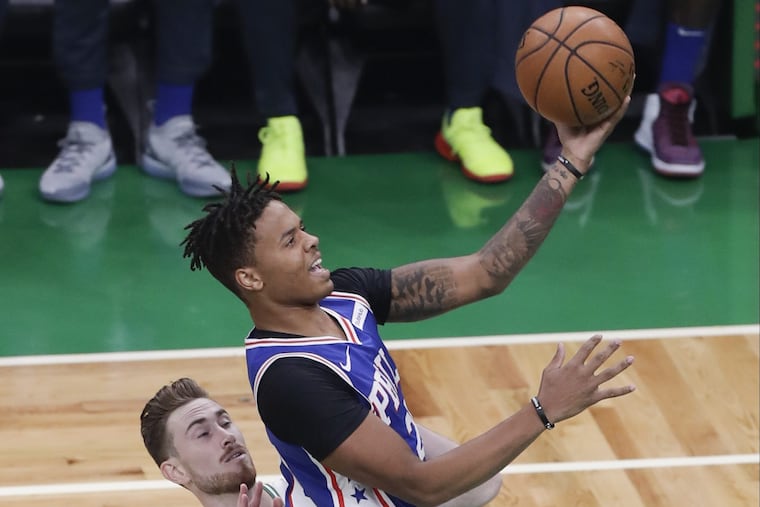If Markelle Fultz doesn’t shoot, Sixers’ lineup combos don’t work
Brett Brown's lineup experiment lasted just one half. Joel Embiid needs shooters around him, and Markelle Fultz and Ben Simmons playing together didn't help the 76ers' cause.

BOSTON — The Boston Celtics were able to quickly exploit the Sixers' weaknesses in Tuesday's season opener, and those weaknesses were highlighted by coach Brett Brown's experimentation with the lineup.
Brown opened the season as he said he would: Markelle Fultz was in the starting lineup and JJ Redick on the bench, then the two swapped to start the second half. The reason for putting this plan into action, according to Brown, was to surround Fultz with the team's best talent to inspire confidence while helping him develop, and to give him more reps as a point guard.
The problem is that when Fultz is with the starting unit, the Sixers' biggest flaw is on display. At this stage, Ben Simmons is a point guard who is unwilling to shoot from distance. Add Fultz to that equation, and the Sixers are a team with too few shooters surrounding their front court.
Instead of defending players who don't demand respect on the perimeter, the Celtics were able to sag off from Simmons and Fultz. This allowed Boston to make quicker transitions on help defense and double teams, and they were able to deny the Sixers' entry passes by clogging up lanes.
"I give credit to [the Celtics] just overplaying lanes and using their athleticism, they did bother us in the playoffs on some of the entries," Brown said following the 105-87 loss in Boston. "Other bits are maybe a little bit where they're not as threatened by some of the perimeter problems."
If the goal is for Joel Embiid to improve his post game and to get him the ball more on the block, it's not made any easier when the passing lanes to Embiid are crowded with sagging defenders.
When the defense doesn't need to focus on the ball, it's hard for the Sixers to move the ball and create opportunities anywhere other than side-to-side. Even when Embiid had the ball in his hands on Tuesday, the Celtics turned most of their attention on the center while completely disregarding open players on the perimeter.
After the game, Embiid pointed to the lack of movement as one of the many downfalls of the night and one of the reasons behind it all was the personnel changes.
"There's a couple of new guys on the team and the change in starting lineups, but we've got to figure it out," he said. "We're not used to it."
It's important to note that what Embiid said not only addresses the non-shooting problems but also the chemistry and rhythm of the team during the game. The Sixers have started the season without a clear idea of how substitutions and rotations will work. And with Redick being reinserted into the starting unit in the second half, there is the risk of jarring any rhythm found in the first half as well as reintroducing wrinkles that were ironed out early on.
Is Brown willing to sacrifice wins in order to allow Fultz to develop? Probably not. Fultz played 21 minutes in the first half and just a hair over three minutes in the second. Instead of Fultz, Brown elected to use T.J. McConnell.
"Our memories of T.J. in this building, against Boston, are strong. He had a hell of a series last time we were here," Brown said. "Markelle is going to have steady, slow growth. Sometimes he's going to be incredible and sometimes he's going to be part of the NBA at a very young age on a pretty good team."
If the reason for starting Fultz is to allow him to develop, he has to be willing to shoot the ball. If the reason for bringing him off the bench in the second half is to get him more point-guard minutes, then he can't be placed next to Simmons or McConnell.
To Fultz's credit, he seems to genuinely believe in a team-first approach and understands that some of his growth may come in the form of watching rather than playing.
"When Coach makes a decision that he believes is best, I'm perfectly fine with it," Fultz said. "You grow by sitting on the bench and watching, too. If anything you see what the players on the court can't see."
But if Brown thinks Fultz's journey to improvement will be slow and steady, then he might need to rethink using a starting-five spot as a place for Fultz to boost his confidence. And if this is something Brown is committed to, then Fultz or Simmons — or both — need to start taking more shots.